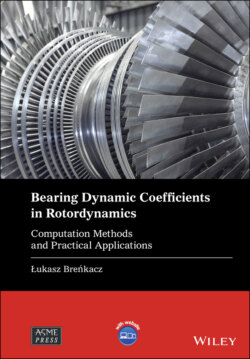Читать книгу Bearing Dynamic Coefficients in Rotordynamics - Lukasz Brenkacz - Страница 11
Оглавление
List of Tables
| Table 3.1 | Successive eigenfrequencies and the corresponding damping values calculated for the laboratory test rig. |
| Table 5.1 | Parameters of the numerical model. |
| Table 5.2 | Stiffness coefficients. |
| Table 5.3 | Damping coefficients. |
| Table 5.4 | Mass coefficients. |
| Table 7.1 | Summary of the real and calculated stiffness, damping and mass coefficients for the two bearings for the reference case; representation of the relative calculations error. |
| Table 7.2 | Summary of the real and calculated stiffness, damping, and mass coefficients for the two bearings for a case with displaced force; results “with correction” take into account the uneven distribution of excitation force in the calculation procedure. |
| Table 7.3 | Summary of the real and calculated stiffness, damping and mass coefficients for the two bearings for a case with an excitation at an angle of α = 15°. |
| Table 7.4 | Summary of the real and calculated stiffness, damping and mass coefficients of two bearings for an asymmetrical rotor. |
| Table 8.1 | Stiffness, damping and mass coefficients of the rotor–bearing system for the entire speed range. |
| Table 8.2 | Standard deviation of stiffness, damping and mass coefficients of the rotor – bearing system for the entire speed range. |
| Table 9.1 | Parameters of the numerical model in the KINWIR program. |
| Table 9.2 | Stiffness and damping coefficients obtained from linear calculations in the KINWIR. |
| Table 9.3 | Minimum and maximum values of stiffness coefficients (N/m) calculated in the NLDW program. |
| Table 9.4 | Minimum and maximum values of damping coefficients (N·s/m) calculated in the NLDW program. |
| Table 10.1 | Comparison of the calculated stiffness and damping coefficients for the three methods used for a speed of 3000 rpm. |
